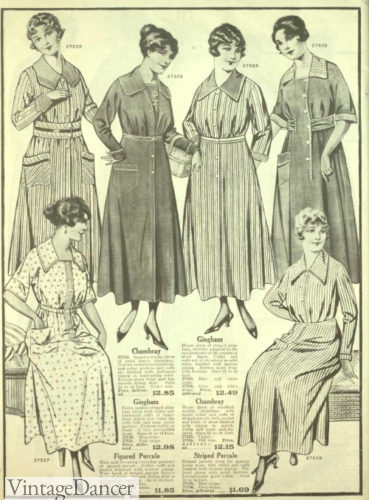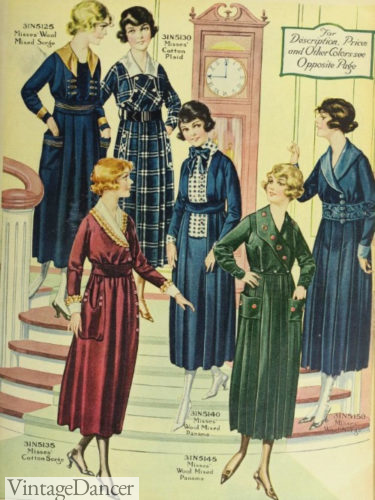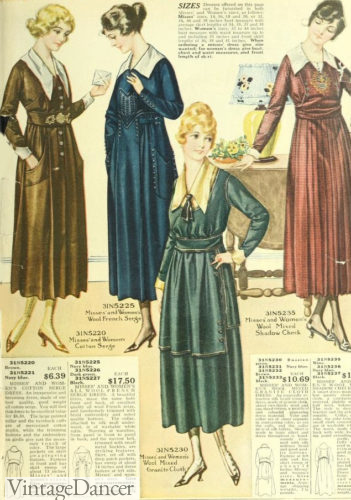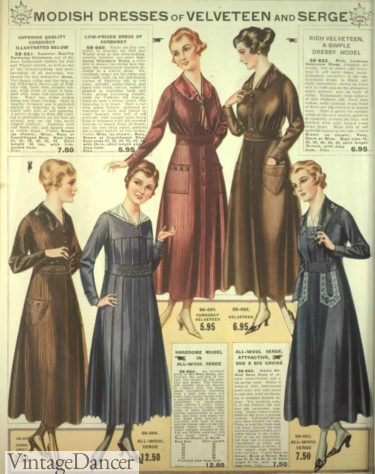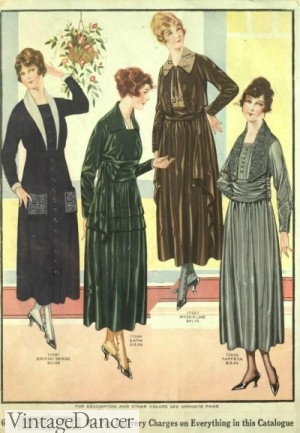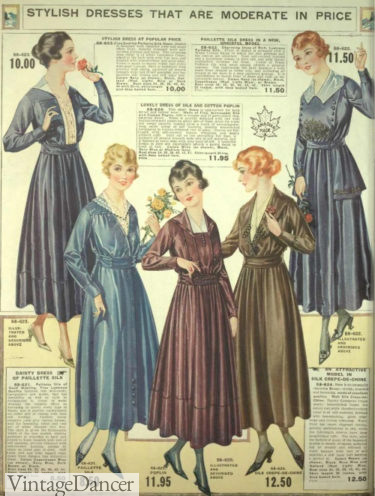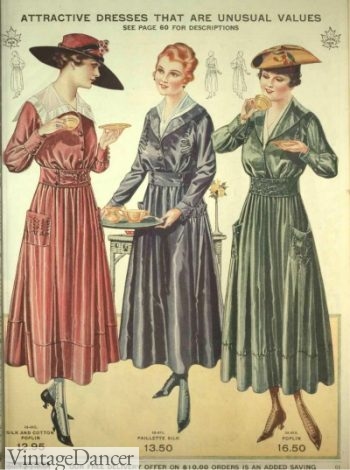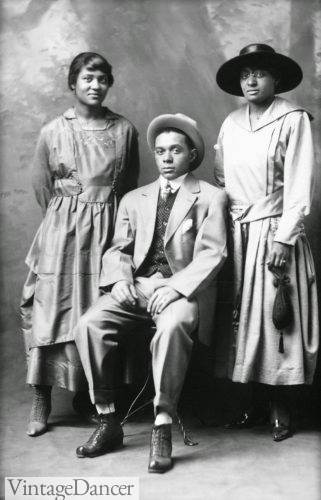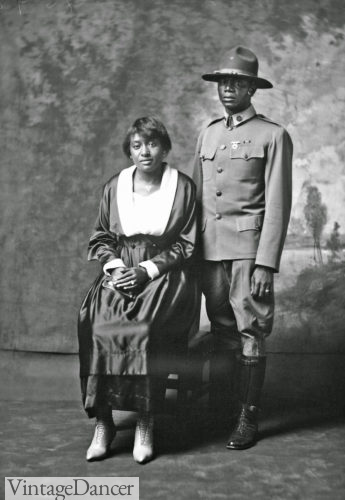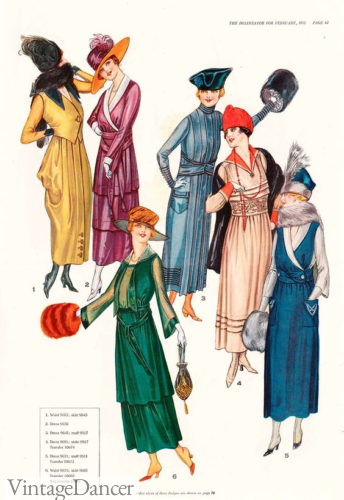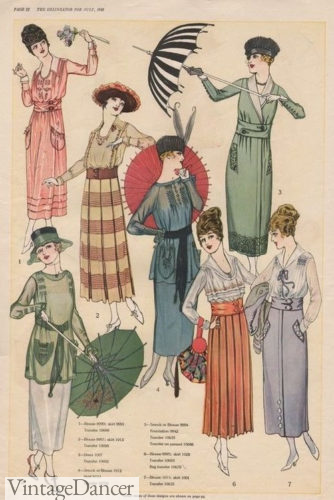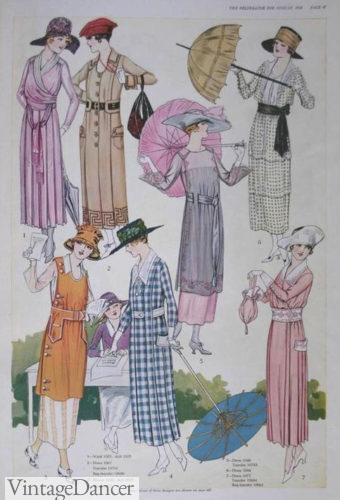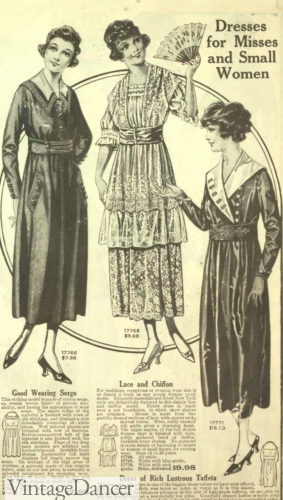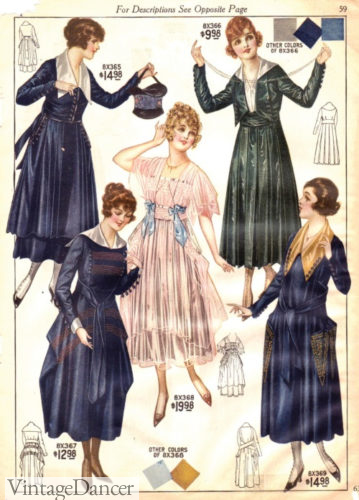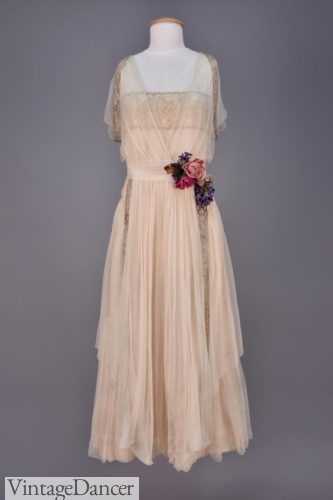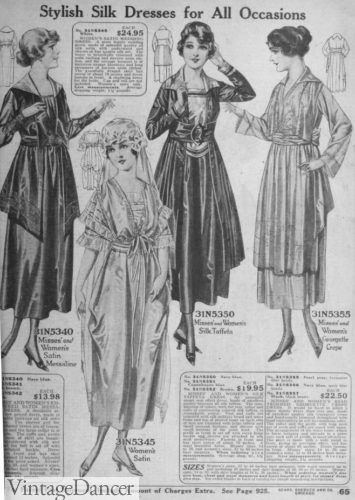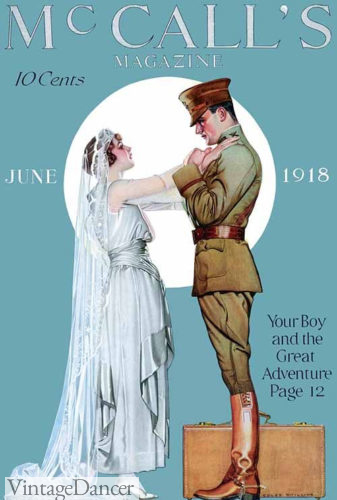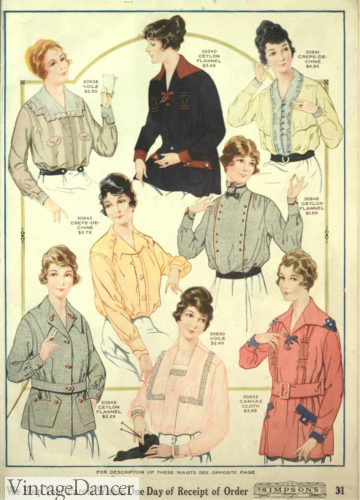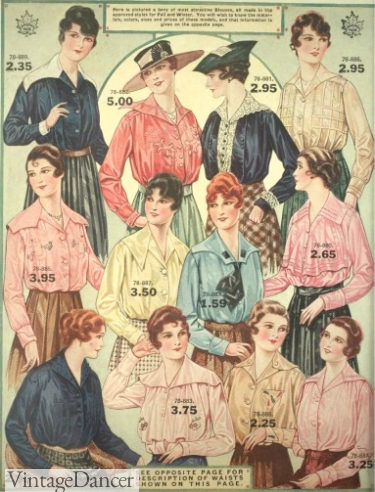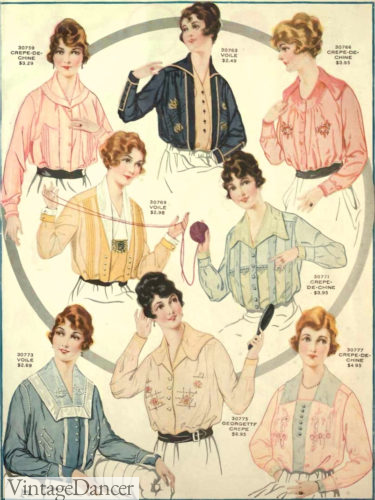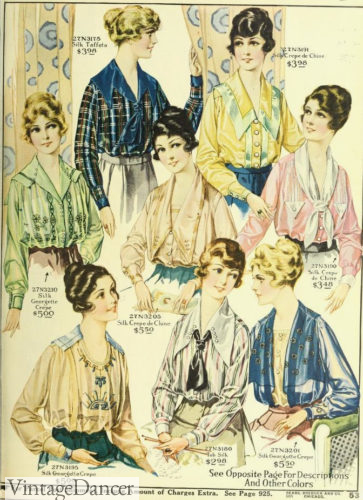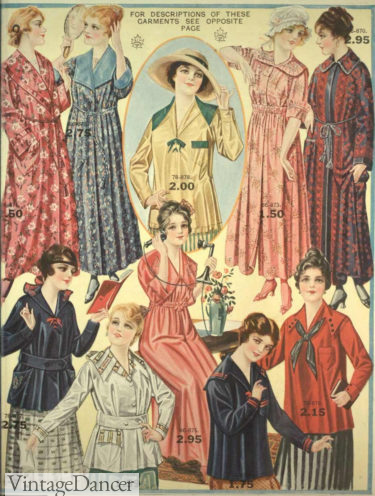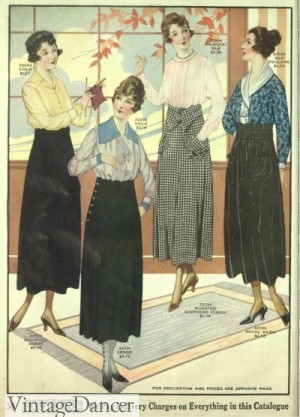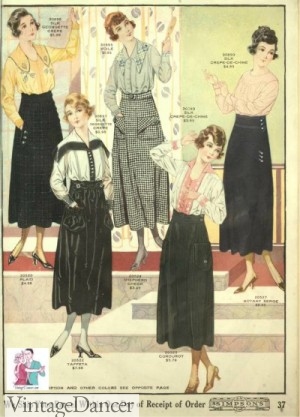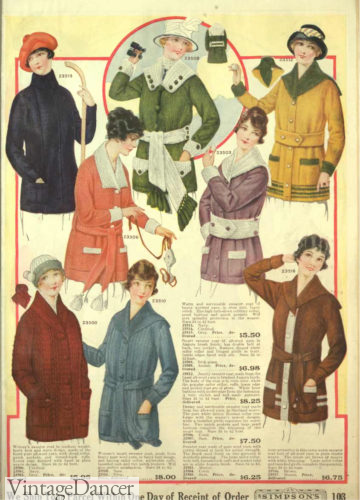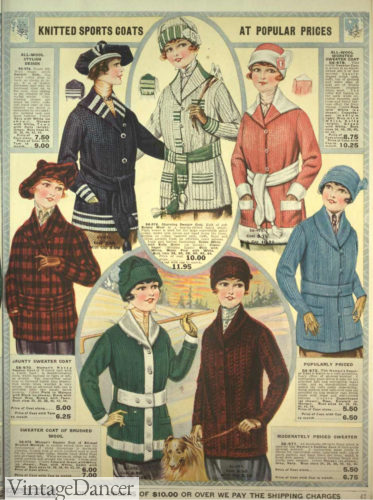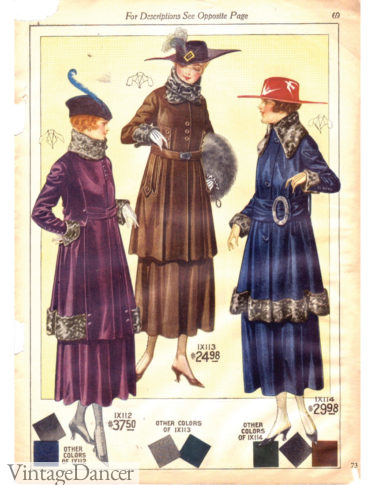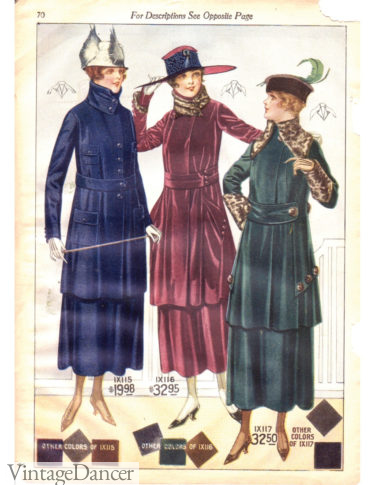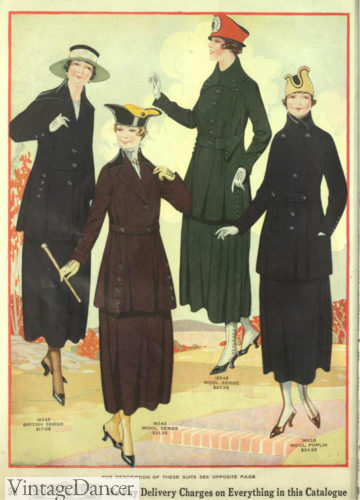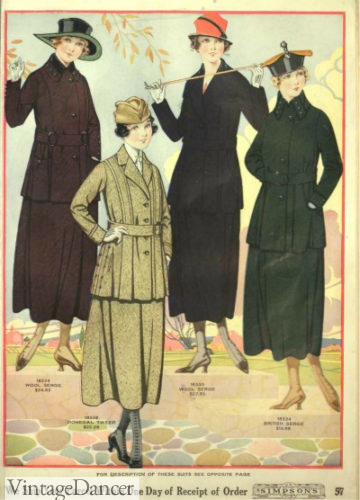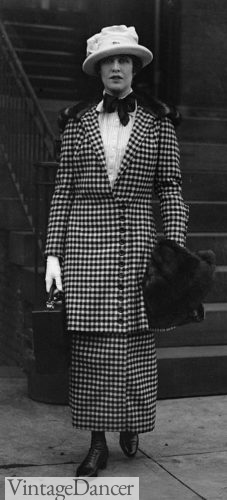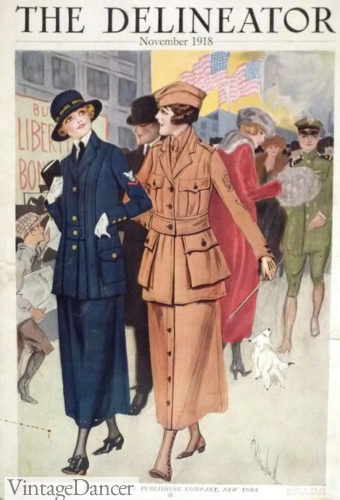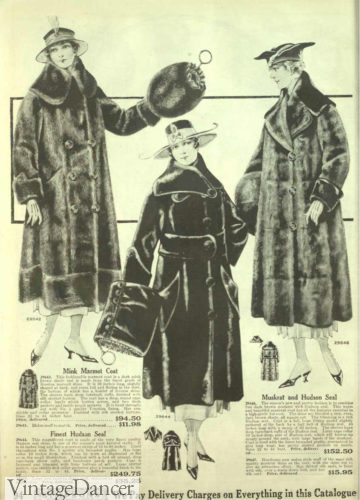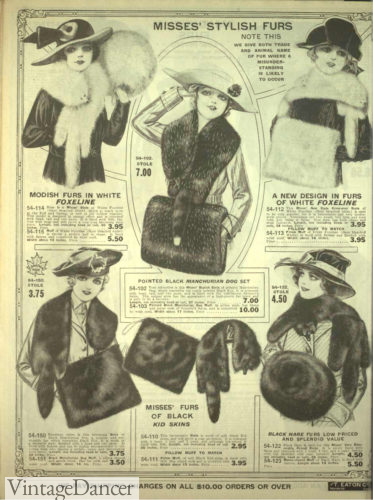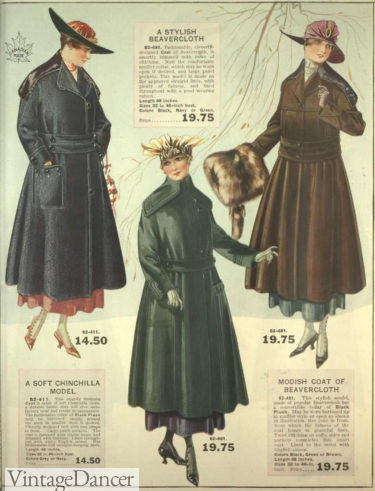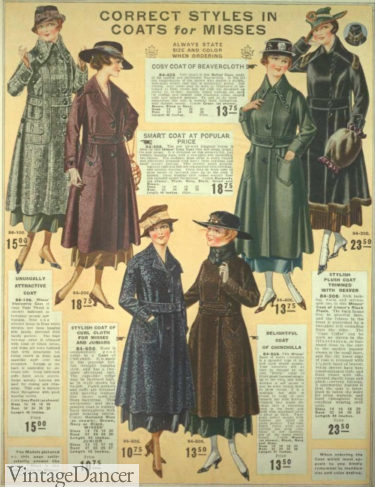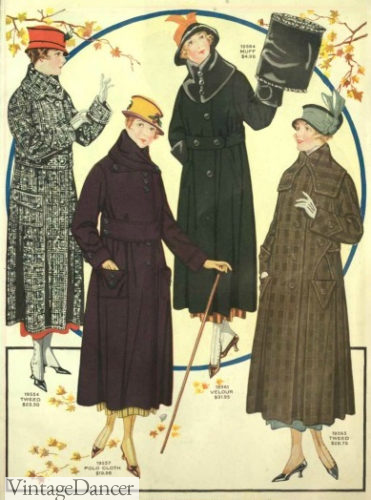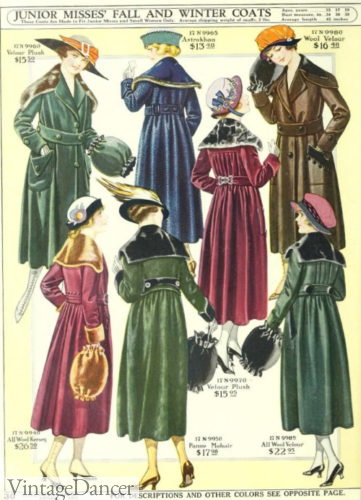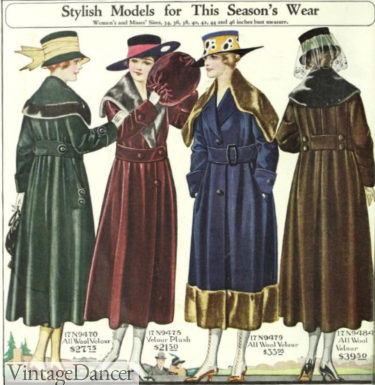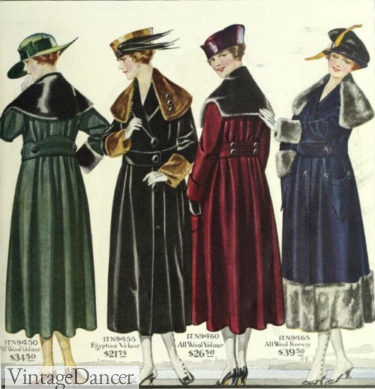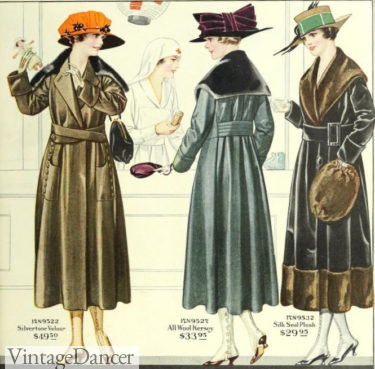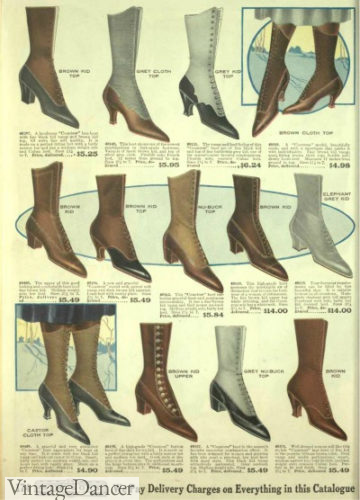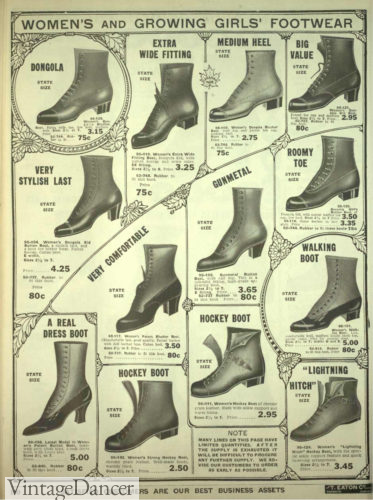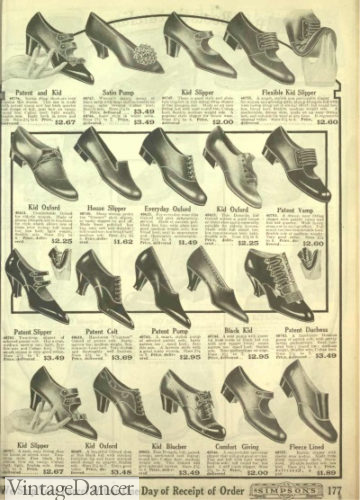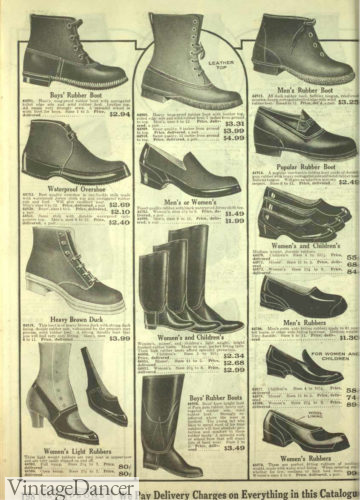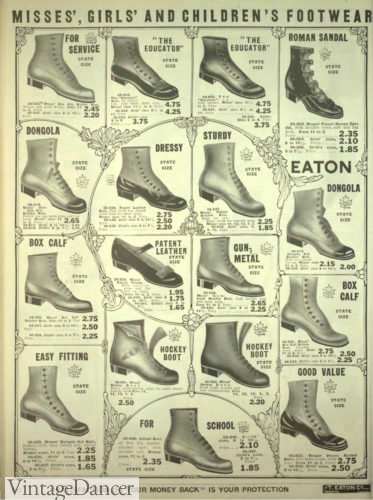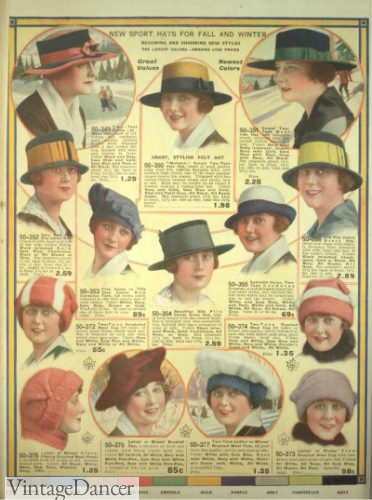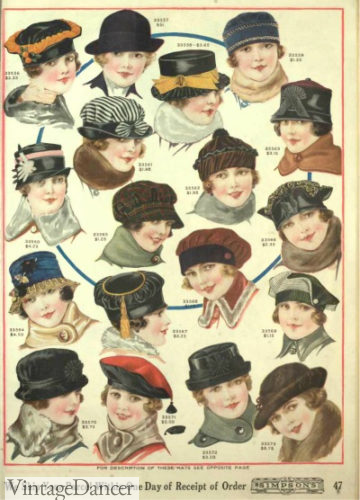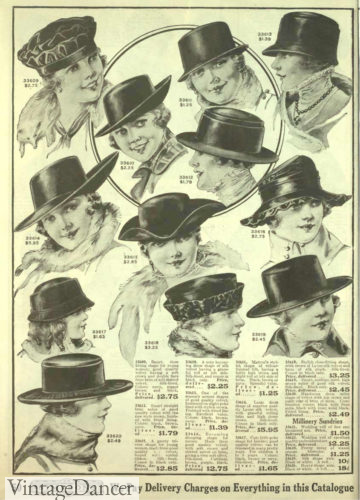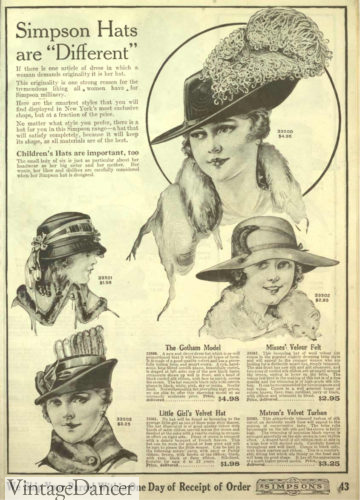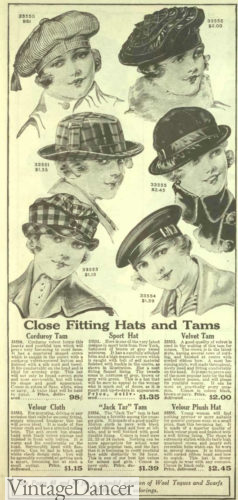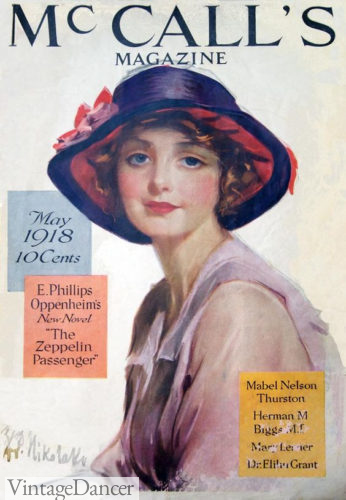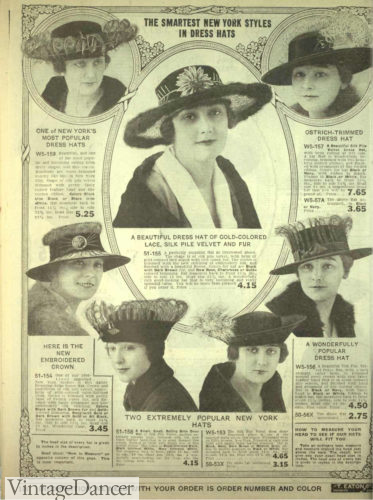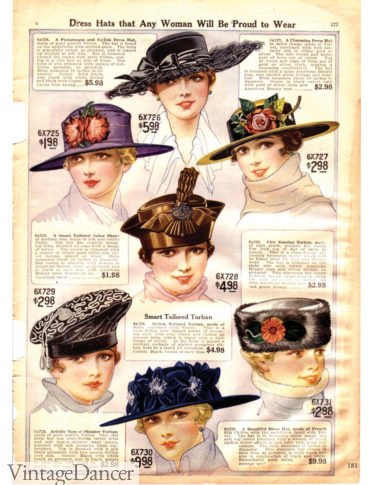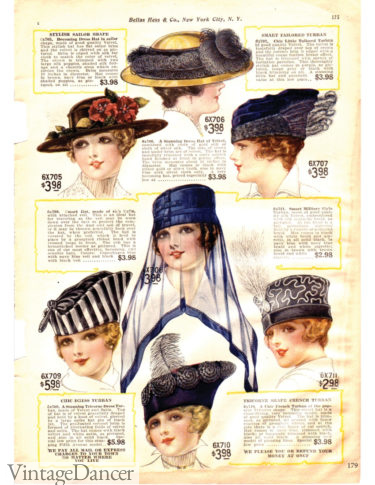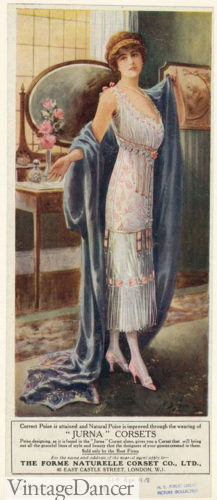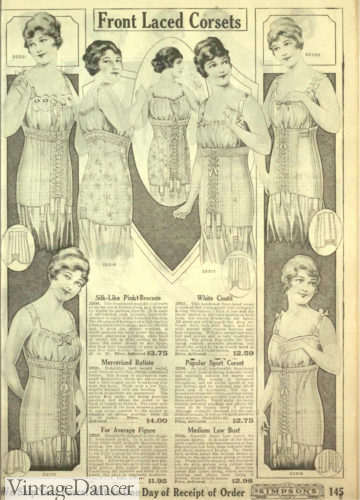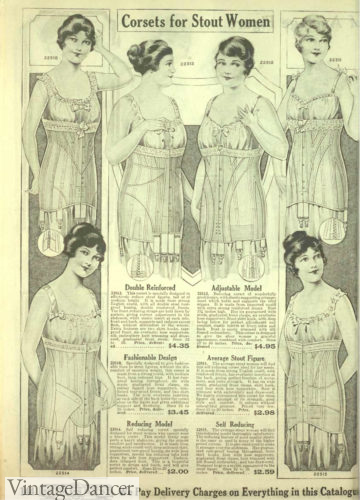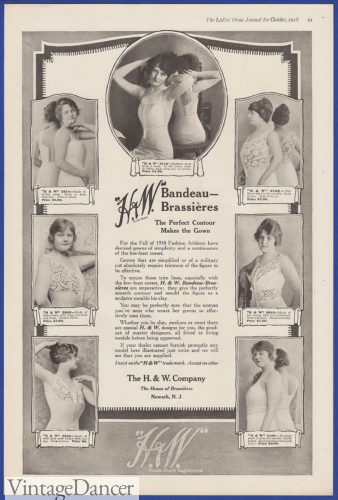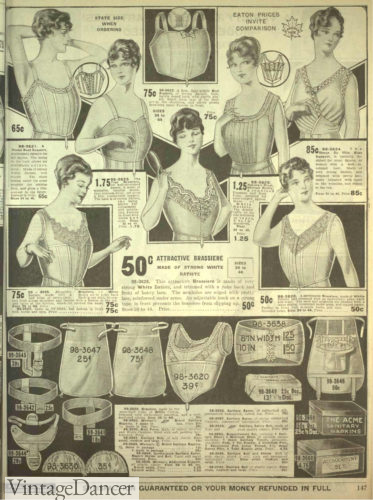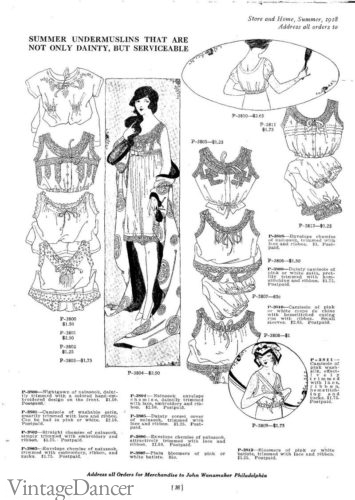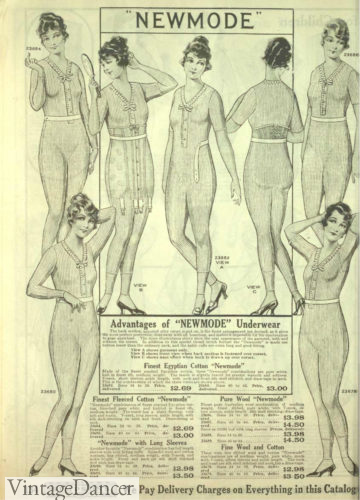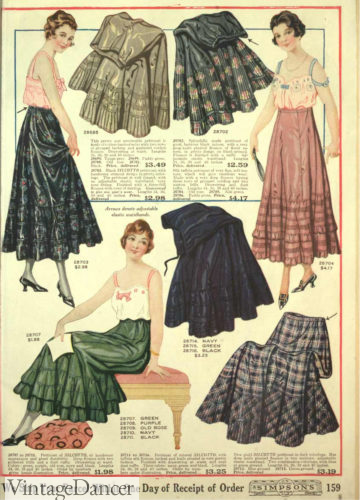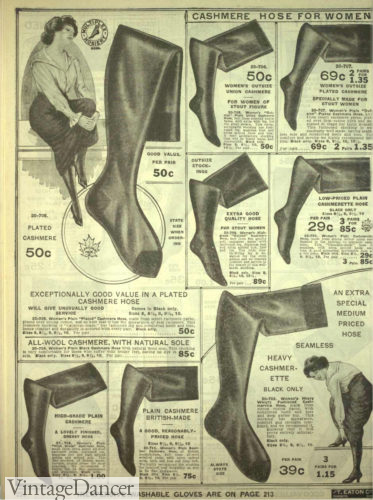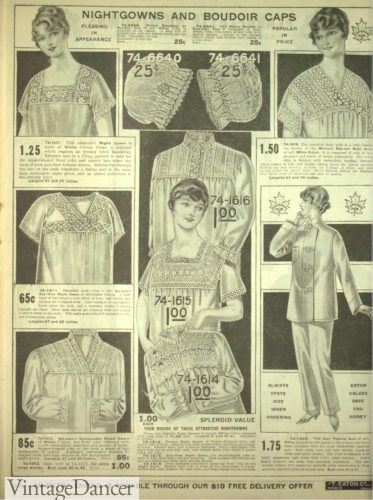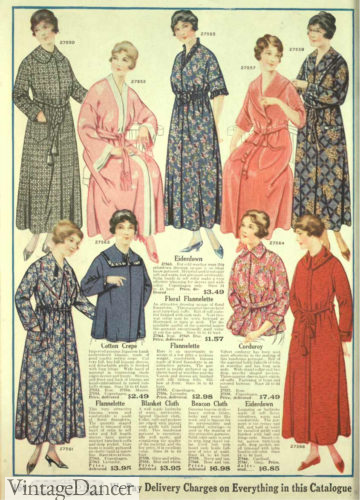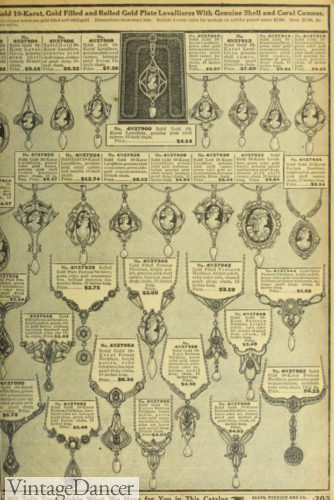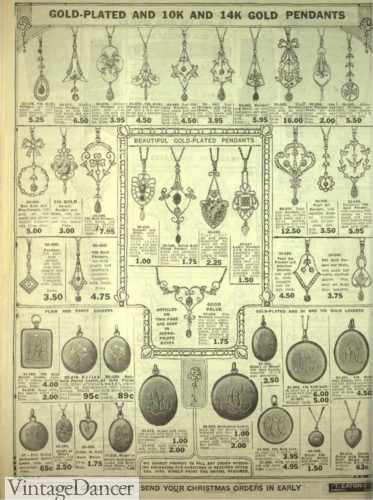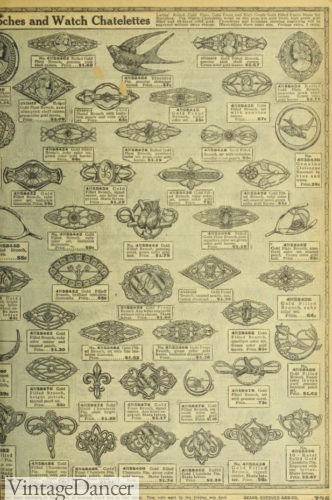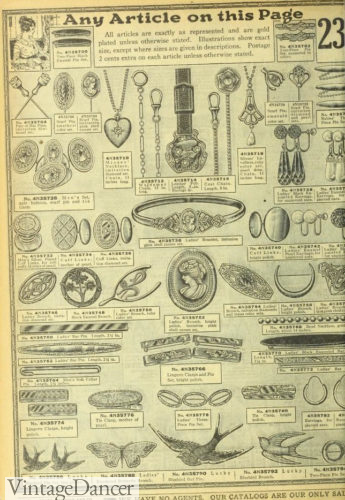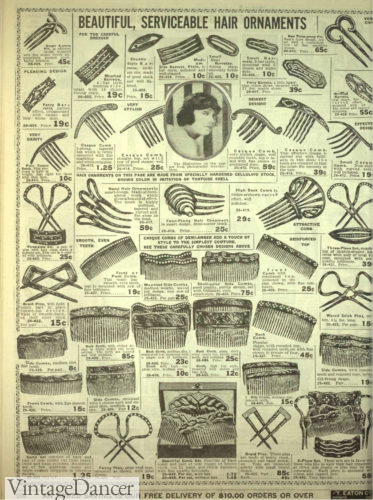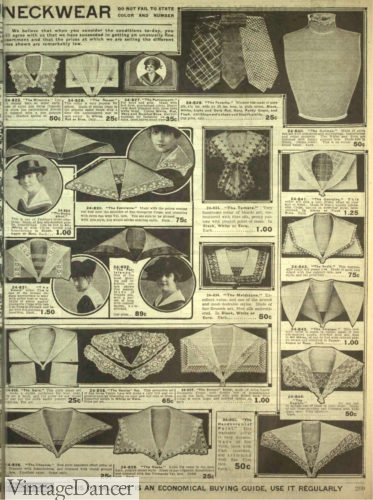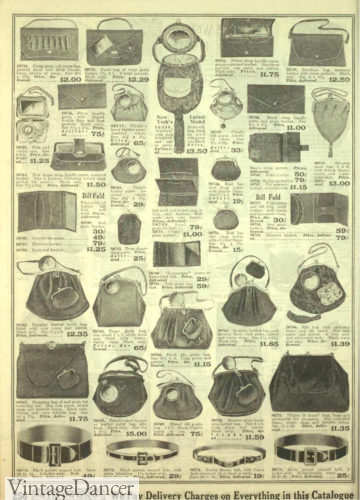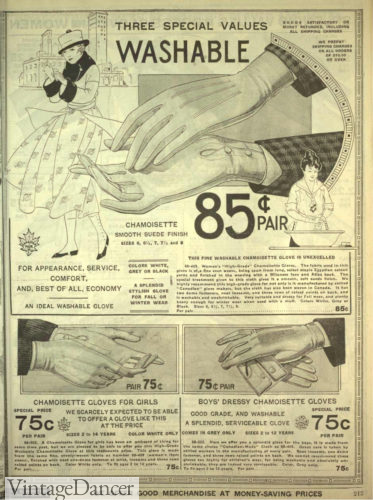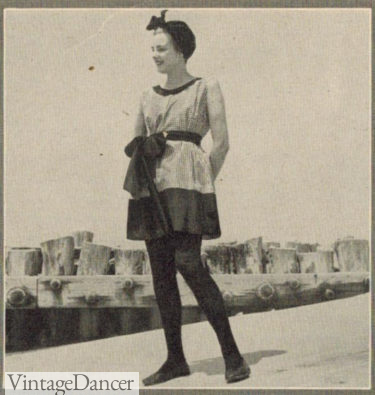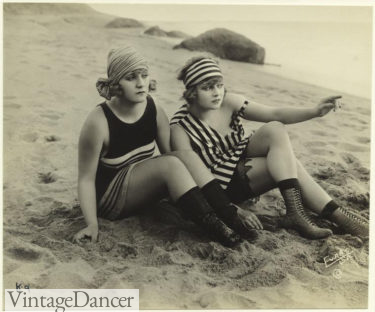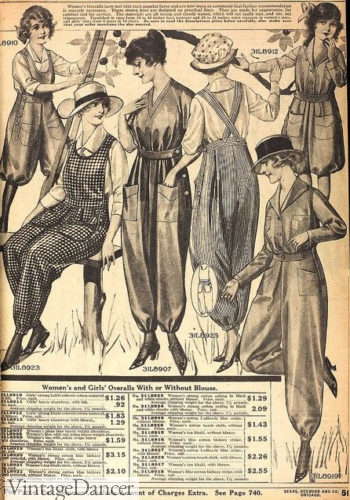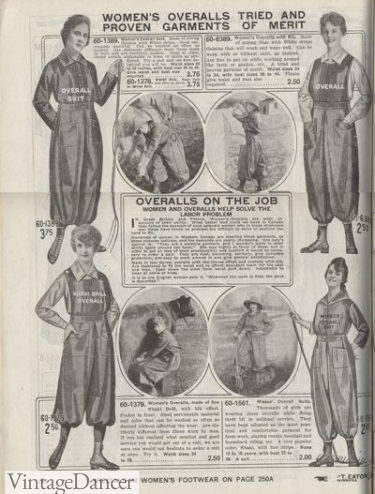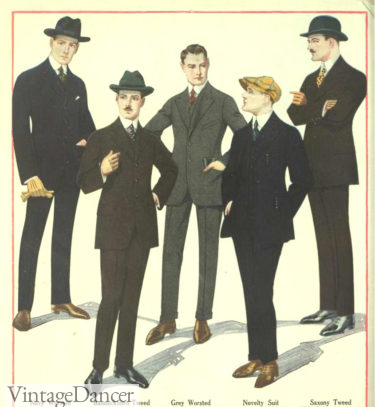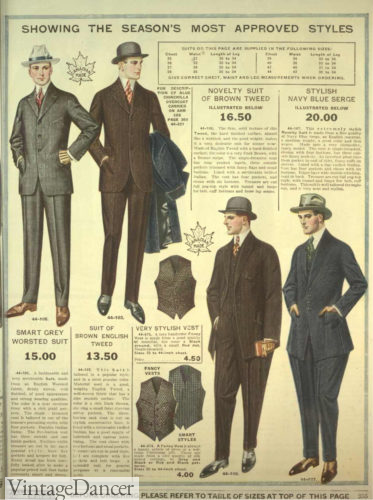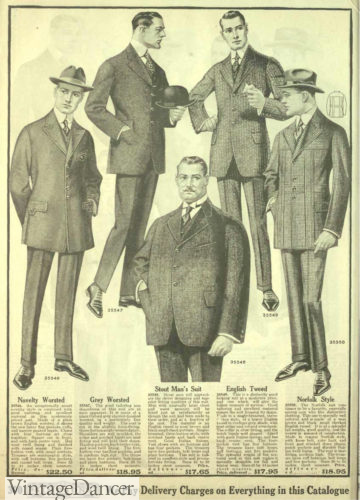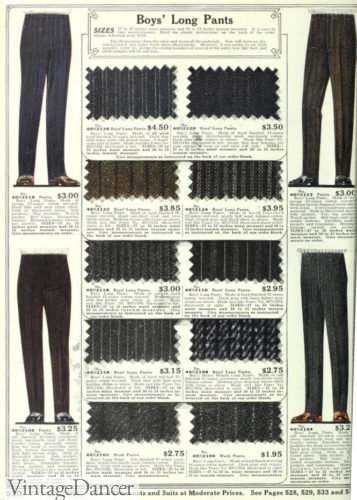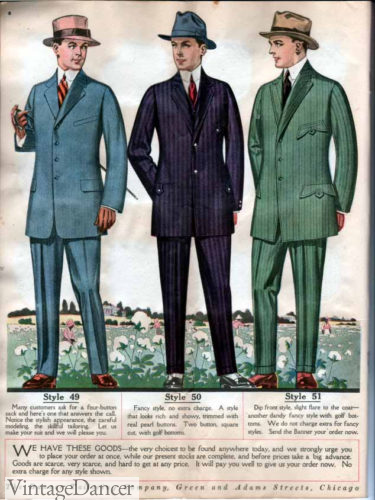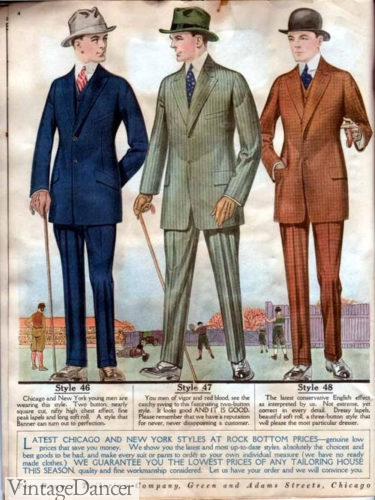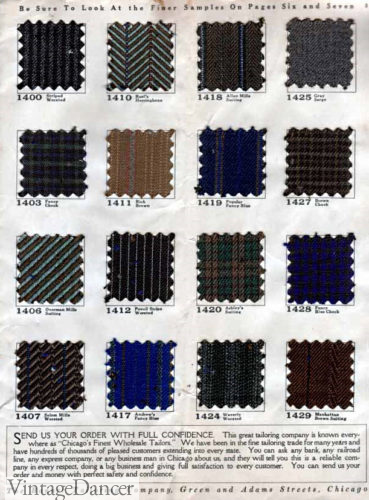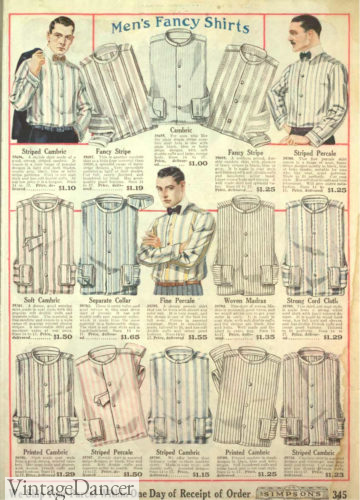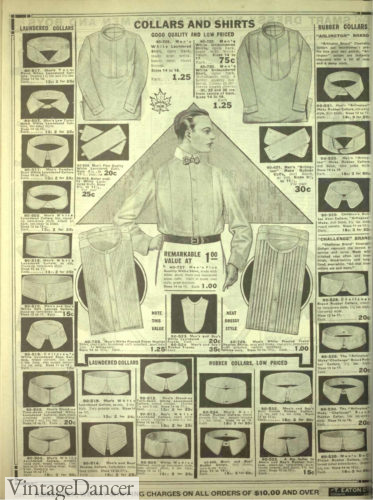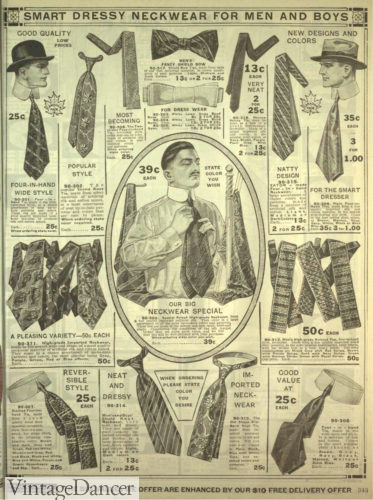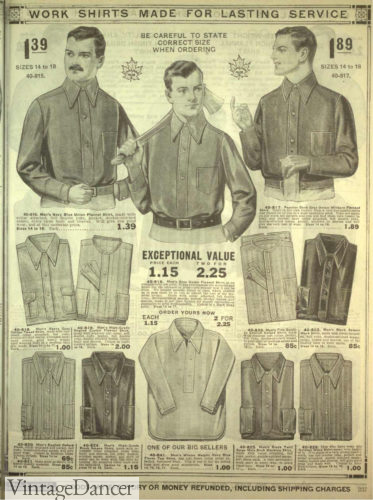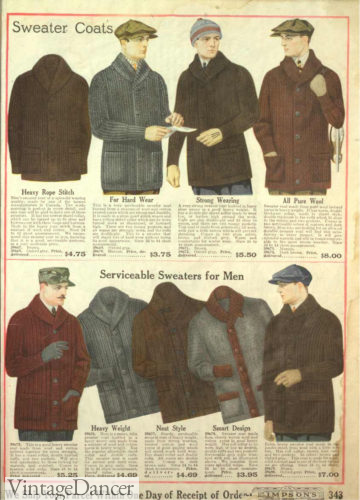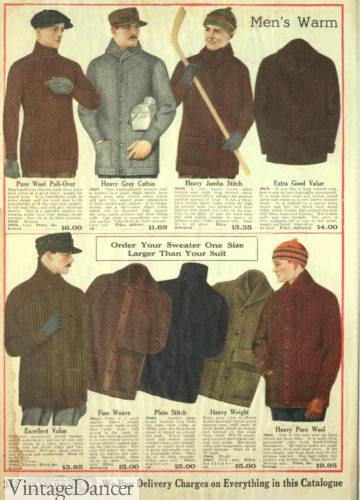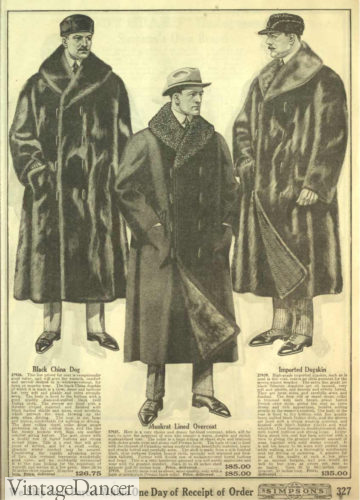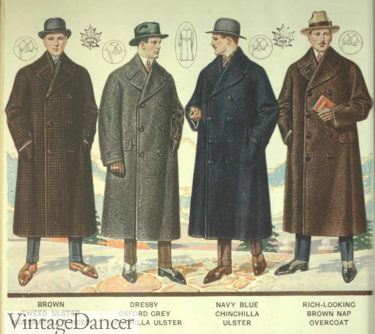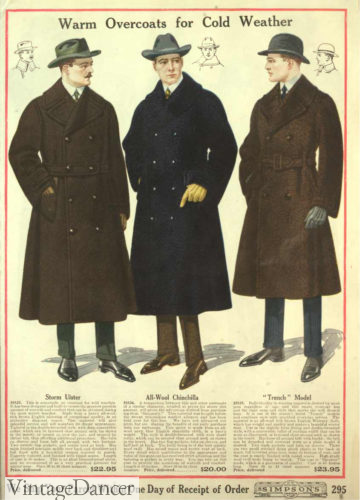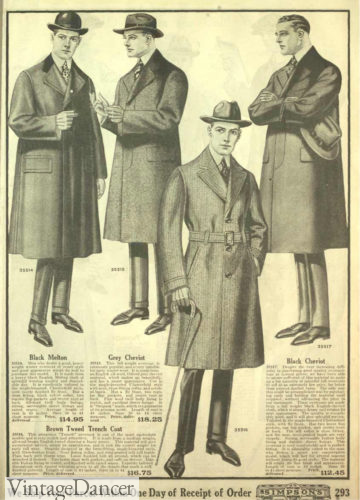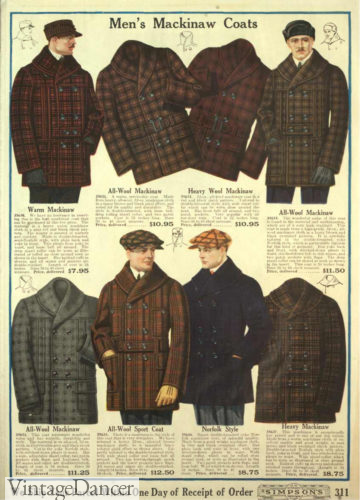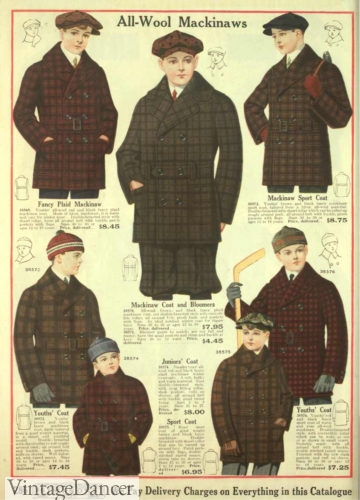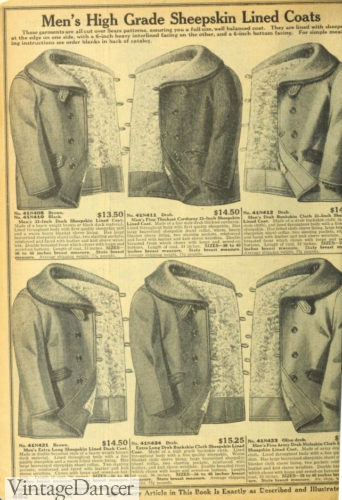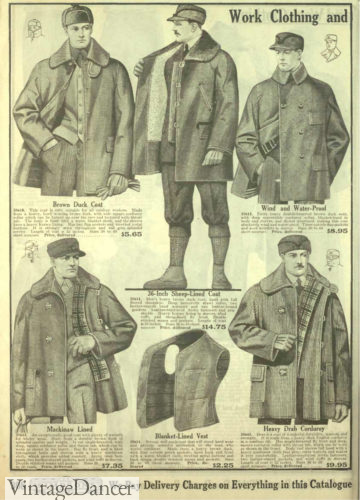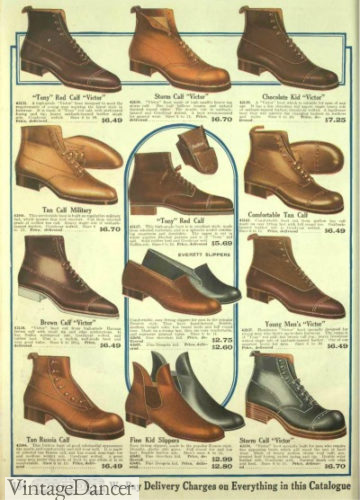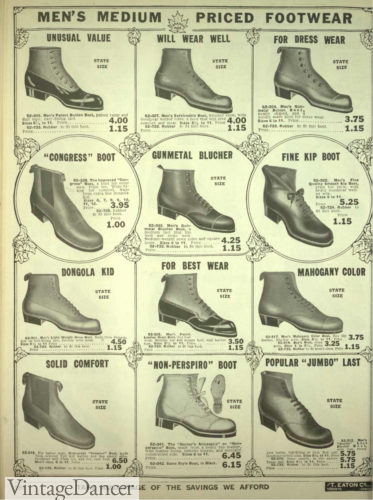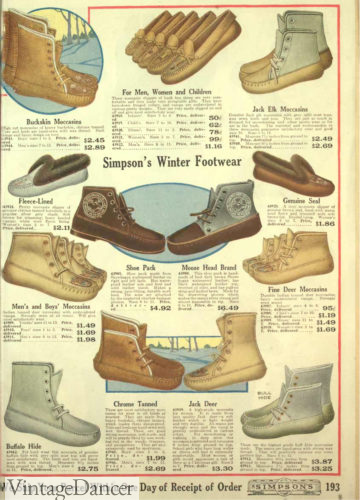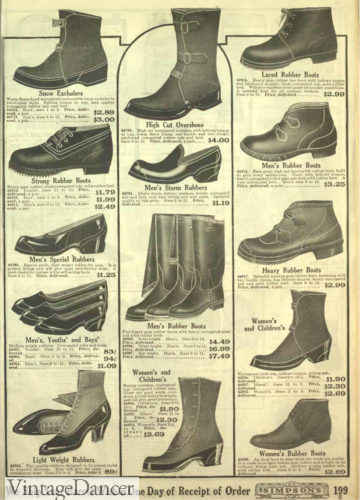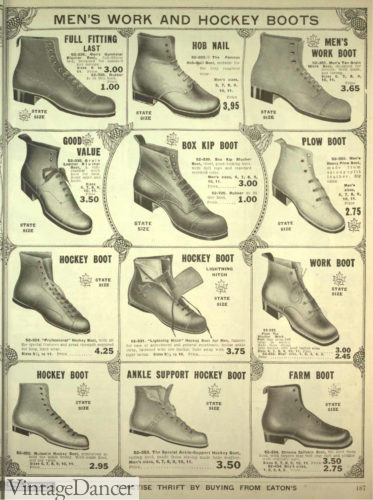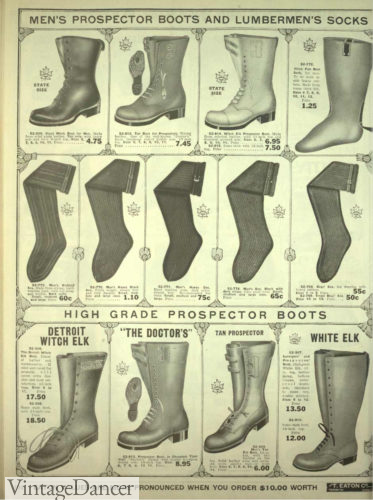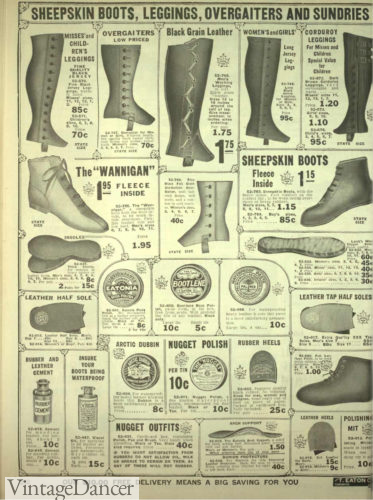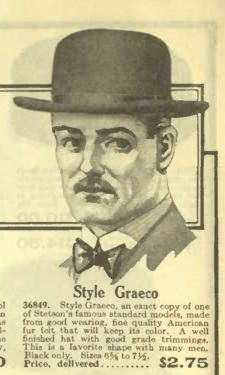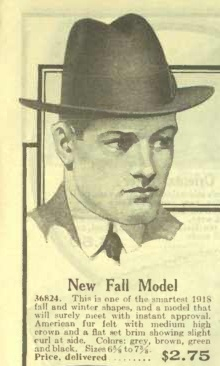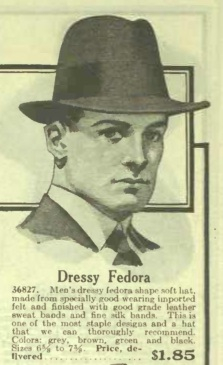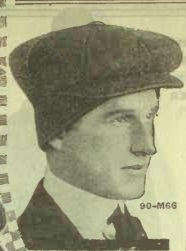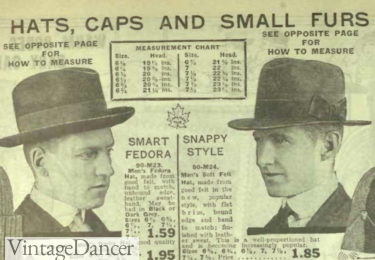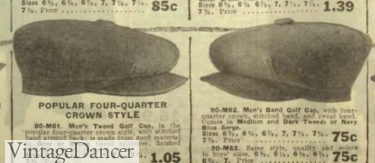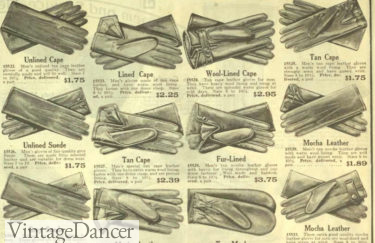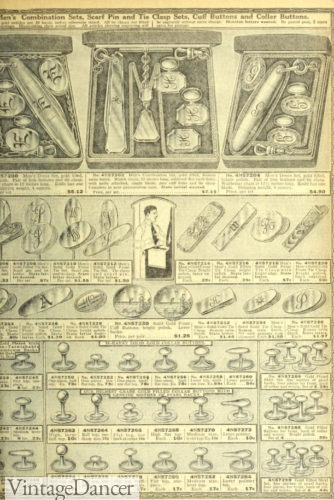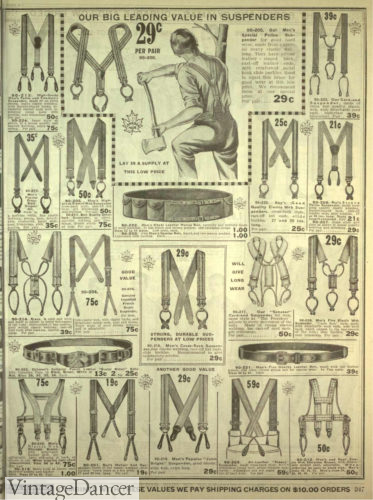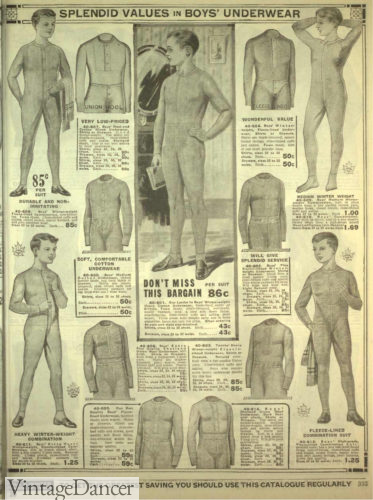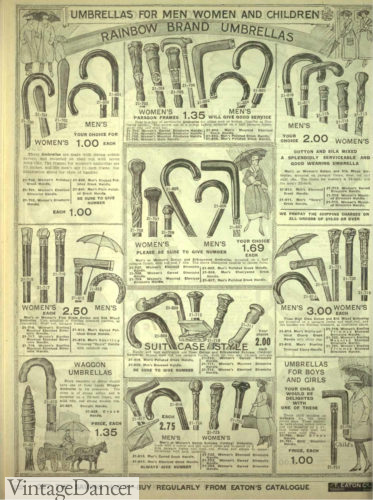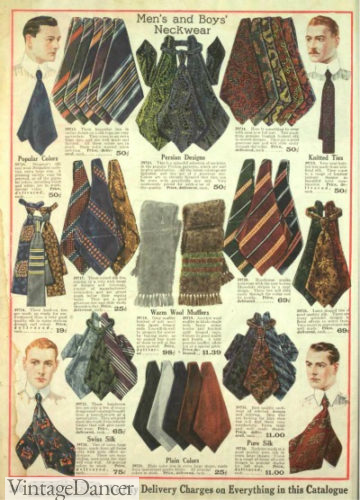1918 was the last year of the first World War. With it began a change from wartime austerity to freedom in dress and fit and color. Both women’s and men’s 1918 fashion were at a pivoting point, lasting until 1922 when the Roaring Twenties changed things again. For women, fashion was looser, with shorter hemlines and widths that were full but required only one light petticoat. Sleeves were long but narrow, with wide collars and sashes, big pockets, and contrasting buttons. For men, the super skinny Jazz suit was designed for young men returning to post WWI civilian life in good physical shape. Colors for both women and men were still drab and conservative in Britain, but gaining more color in Paris (France) and America. Blue, green, burgundy, and brown made up winter stock while white, light blue, pink, and lavender cheered up spirits in spring and summer.
The following is from my collection of 1918 fashion catalogs and found photographs. It is a visual guide to the fashion year 1918, mostly in America and Canada, with a bit of history to set the context.
1918 Ladies Fashion – Day Dresses
“Wide at the hips and narrow at the ankles,” said Vogue in January 1917. The new Barrel line created the illusion of fullness, but lacked the layers of the previous years. Clothing was draped loosely around the torso with big folds, drapes, and gathers around the skirt sides. Oversized collars, belts/sashes, pockets, and embroidered or lace panels exaggerated the size. The waistline sat just above the natural waist, dropping down from the empire waist of 1910-1914. Sleeves were long, even in summer, where sheer sleeves were incorporated.
At home, house dresses were small cotton percale stripes, solid chambray, and gingham checks. For visiting, shopping, traveling, or other daytime pursuits, women’s dresses were made up in rich fabrics — taffeta, velvet, silk, crepe, and corduroy. Large collars framed the shoulders and provided a place to add some decoration. Overall, women’s dresses were simple, not fussy, and practical for all kinds of activities, from morning to night. Only the wealthy could afford dresses for all occasions. Most women had only 2 or 3 dresses to choose from. Shop day dresses.
- 1818 house dresses made of chambray, gingham check, and percale cotton stripes
- 1818 house and day dresses in solid colors (one in plaid.) Several have wrap tops with shawl collars.
- 1818 winter day dresses with embroidery
- 1818 Velveteen and corduroy winter dresses
- 1918 Silk Dresses- Worn for day or afternoon. Notice the high waistline but with a large waistband. The length has also shortered to an easier walking length (and getting in and out of cars and buses)
- 1918 spring silk dresses
- 1918 day dresses- less full, still modest
- Portrait of W. H. Harrington family, 1918
- Portrait of Soldier, William Jackson, M.s.s. and wife, 1918
- February 1918 French spring fashions in brighter colors
- July 1918 French new fashions in summer dresses
- 1918 August French fashion – casual or dressy
1918 Tea Dresses to Ball Gowns
There were few events the average woman needed to dress up for. Typically, a fancy day dress was all that was needed for evening events, but the daytime tea party was an exception. The all white lace and chiffon tea dress was a summertime necessity. Ballgowns were similarly light and airy chiffon tea length party dresses with ribbon bows or clusters of flowers placed at the waist. The sheerness and lightness were inspired by Ballerinas. Shop evening dresses.

1914-1918 evening dress guide. More
Wedding gowns, if a bride could afford one, were modeled after fancy afternoon dresses, not tea dresses or ball gowns. They often combined a heavy fabric base with sheer light draping on top. Antique heirloom lace accented the floor length veils as the “something old.” Wedding dresses were white or close to white. Less affluent brides may have worn a light colored dress or ivory flannel suit. Shop wedding dresses.
- 1918 Lace tea dress
- 1917-1918 Party dress in the center
- 1918 Evening dress
- Silk dresses and white wedding dress 1918
- June bride, 1918
1918 Skirts, Blouses and Sweaters
The use of separates instead of one-piece dresses increased significantly in 1918. Skirts were simple shapes with a mid-calf tea-length. Details such as white side buttons, large pockets, and wide gathered waistbands matched those of dresses. The skirt sat high on the waist in which a blouse or “shirtwaist” was tucked into and billowed out slightly. Blouses were very pretty and embellished with embroidery, pintucks, covered buttons, and large contrast collars. They could be fancy or casual with most leaning towards the later. The Middy blouse was the sportiest design with a sailor collar and necktie worn over the skirt, sometimes with a matching belt or sash. Shop blouses and skirts.
Knitwear in winter was continuing to climb out of “only practical” to fashionable attire for women’s casual winter clothes. Homemade knit cardigan sweaters hung down low around the hips with a tie scarf-sash or button belt to emphasize the waist. Many featured white or contrasting cuffs and collars, which helped add some cheer to long winters. They were often knitted with matching hats, mittens, and scarves.
- 1918 house blouses made of durable cotton, wool
- 1918 light blouses
- 1918 spring blouses
- 1918 spring blouses
- Middy Blouses (robes up top)
- 1918 Skirts and blouses
- 1918 winter skirts
- 1918 knit sweaters with belts
- 1918 knit sweaters with belts
1918 Women’s Suits
While sweaters were for casual attire or layering for warmth, a two-piece suit was practical for street wear. A matching skirt and coat were sold together in fabric and weights to match the season. Many suits were adapted to women’s service uniforms. Made of wool, they were extremely durable but dull. In luxury fabrics such as velvet, they could be as pretty as dresses. The checkered suit became trendy, breaking up the monotony of solid dark suits.
- 1918 fur trim winter suits
- 1918 winter suits
- 1918 walking, traveling suits
- 1918 sport suits, walking suits
- Princesse de Polignac, née Winnaretta Singer
- 1918 fashion
1918 Coats
When a dress was worn, a long overcoat was necessary for winter. In the coldest climates, an all fur single or double-breasted coat was sold with a very large hand muff. Less cold areas only required a wool coat with an optional fur stole to drape across the shoulders. Spring coats were lighter and brighter with removable fur collars. Plaid and check coats were welcome casual options.
- 1918 fur stoles, shawls and muffs
- 1918 wool coats
1918 Shoes
Boots, boots, and more boots. Most women wore boots when leaving the house. Plain brown or black lace-up boots were wardrobe essentials, but the new spat top two-tone boot was very fashionable. Brown and grey, black and brown, or black and white/ivory were visible under the shorter hemlines. Side buttoning boots added even more variety as well as heights that topped the calf or just a bit over the ankle. For rain and snow, rubber boots and slip on shoes were worn instead.
At home or in springtime, women could wear simple heels, multi-strap pumps, or short Oxfords. Heel eight ranged from a low 1-inch to a moderate 2.5 inches. In the evening, a satin pump often matched the ball gown. Shop boots and shoes.
- 1918 boots and pumps
- 1918 Women’s boots
- 1918 oxfords and pumps
- 1918 rubber boots and shoes
- 1918 women’s and girls shoes and boots
1918 Ladies’ Hats
From 1915 onward, the trend for small hats with vertical trim replaced the giant pictures hats on the 1910s. Tricorne and bicorn hats added dimension. Smaller picture hats, some with transparent brims, created lovely summer hats. Flat brim sailor hats were worn in summer and winter. Their simple shapes and lack of decoration made them perfect with wool suits. Feathers were minimal, preferring instead the manipulation of fabric to sculpt the hat and decorate it with ribbons and bows.
In winter, casual and close-fitting hat such as the tam or floppy beret made of velvet kept heads warm. Hats with turned down brims began to take the shape of the cloche hat. Shop hats.
- 1918 fall winter hats
- 1918 winter hats
- 1918 hats
- 1918 hats
- Close fitting hats and tams
- May 1918 picture hat
- 1918 spring hats
- 1917 winter hats
- 1917 spring hats
1918 Underwear, Lingerie
A good foundation was as important as ever. For most women, that meant owning a longline corset that fit from under the bust to over the hip. The loose style of clothing in 1918 made it possible for some small figured women to go without a corset, at least at home. Corsets were worn over a chemise. Some women opted for the new brassiere either instead or in addition to a corset. It had a chemise or vest type top with a short length that tightened under the bust. They were not enhancers so much as supporters for the full chested. In Edwardian times, big busts were in, but they could not jiggle.
Attached to corsets were garters that held up stockings. Cotton lisle or cashmere black stockings were what every woman wore. Silk stockings were made available in a rainbow of colors and were worn with evening attire and summer tea dresses.
Petticoats were what gave skirts their fullness. They were brightly colored and patterned — a woman’s secret beneath otherwise dull outerwear.
For sleepwear, women had the choice of traditional white nightgowns trimmed in lace or the new Asian pant and top pajama set.
- 1918 corset, slip
- 1918 front lace corsets
- 1918 corset for plus sizes
- 1918 bra / brassiere
- 1818 bra / corset cover and sanitary belts
- 1918 underwear: corset covers, bras, slip
- 1918 long underwear
- 1918 petticoats
- 1918 stockings
- 1918 nightgown, nightcaps, and pajamas
- 1918 Robes
1918 Accessories and Misc
Jewelry – Filigree drop necklaces with cameos, locket necklaces, oval filigree brooches, flower and bird shape pins, and watch chatelettes. Wrist watches were worn by some younger women. Shop jewelry.
Hair combs and bobby pins held back the sides of some hairstyles. A long hair comb fit in the top of a chignon or bun on long hair. Shop hair accessories.
Purses- learn more here.
Gloves- learn the history here.
Beauty – Beauty potions and lotions were plentiful, makeup was worn but not talked about.
- 1918 Cameo Necklaces
- 1918 necklaces and watches
- 1918 brooches and chatelain
- 1918 misc jewelry
- 1918 hair combs, bobby pins
- 1918 neck pieces
- 1918 purses and handbags
- 1918 gloves
- 1918 striped swim dress with sash, black stockings and turban wrap
- Claire Anderson and Rose Carter,1918, stripe swimsuits (Right is knit)
- 1918 overalls/coveralls
- 1918 overalls for women
Swimsuits were loose tunic dresses with attached bloomers. The new all knit swimsuit was just coming into style on the beaches in Paris. Most women were required to wear black stockings to retain modesty. A matching wrap or swim cap and lace up canvas boots finished the bathing costume.
Women who took the place of men at war often found themselves in heavy labor jobs such as farming or factory work. Overalls or coveralls were made for women with full legs and a tight ankle cuff.
1918 Men’s Fashion
I wrote quite a bit already about men’s 1910-1919 fashion here, including casual and workwear.
- 1918 men’s slim suits with hats and caps
- 1918- mens rah rah suits on the lower right
- 1918 suit for all sizes. Norfolk suit on the right.
- Boys and men’s pant, fabric swatches
- 1918 new, colorful suits for young men with a wider jacket
- 1918 new, colorful suits for young men
- 1918 Banner tailoring men’s new suit fabrics
1918 Dress Shirts, Ties and Sweaters
- 1918 men’s striped dress shirts to be worn with detachable collars
- 1918 men’s shirts and collars
- 1918 men’s ties
- 1918 men’s work shirts
- 1918 men’s shawl collar cardigans
- 1918 men’s cardigan sweaters
1918 Men’s Coats & Jackets
- 1918 mens fur coats
- 1918 Ulster coats
- 1918 coats
- 1918 trench coat
- 1918 Mackinaw jackets
- 1918 Mackinaw jackets
- 1918 sheepskin lined jackets (blanket cloth also a common lining)
- 1918 men’s work clothing -vest and jackets
1918 Boots and Shoes
Shop men’s boots and shoes.
- 1918 men’s dress boots and shoes
- 1918 mens boots
- 1918 sports shoes, boots and slippers
- 1918 Rubber boots and shoes for men and women
- 1918 work boots
- 1918 heavy work boots and socks
- 1918 gaiters/spats
1918 Men’s Hats
- 1918 mens derby hat
- 1918 soft felt hat- almost a fedora
- 1918 fedora hat
- 1918 golf cap with ear flaps
- 1918 homburg and fedora hats
- casual or work hats
- 1918 wool, tweed and Frieze cap (R)
1918 Men’s Accessories etc
History of men’s gloves
History of men’s jewelry
- 1918 men’s leather gloves
- 1918 men’s jewelry – shirt and cuff links, tie clips, scarf pins
- 1918 men’s suspenders
- 1918 men’s long underwear
- 1918 canes
- 1918 Mens neck ties
Resources
1918 Clothing as worn in the Wonder Woman movie
1919 Clothing as worn in Mr. Selfridge
Edwardian era fabrics and colors– Fabric swatches and catalog scans
Edwardian era sewing patterns – repro and inspired patterns from 1900 to 1919
Edwardian era dresses – Need an 1918 costume? Also, look in 1920s day dresses for some options.
Great War Fashion by Lucy Adlington
1918 Sears catalog- see the entire Sears catalog from fall and winter 1918
Women’s Fashion During WW1 – Article
The World and Fashion in 1918 – Fashion historian Jonathon Wolford’s informative summary
War Time Fashion 5 part series about women’s clothing during WWI
Need more help? If you are looking for something not pictured here, just ask!
Debbie Sessions has been teaching fashion history and helping people dress for vintage themed events since 2009. She has turned a hobby into VintageDancer.com with hundreds of well researched articles and hand picked links to vintage inspired clothing online. She aims to make dressing accurately (or not) an affordable option for all. Oh, and she dances too.
